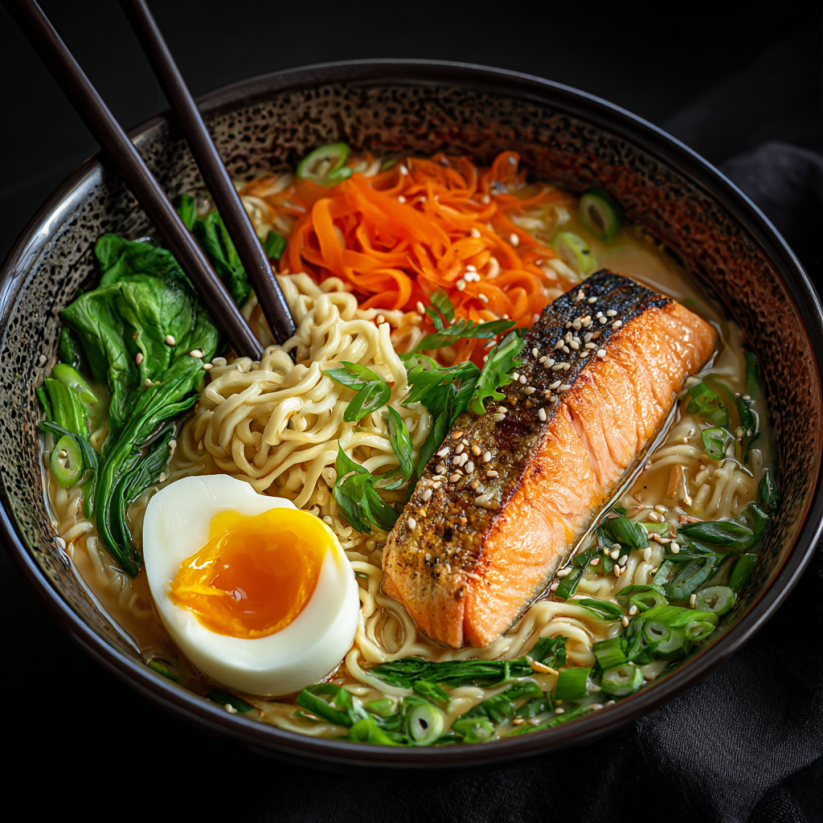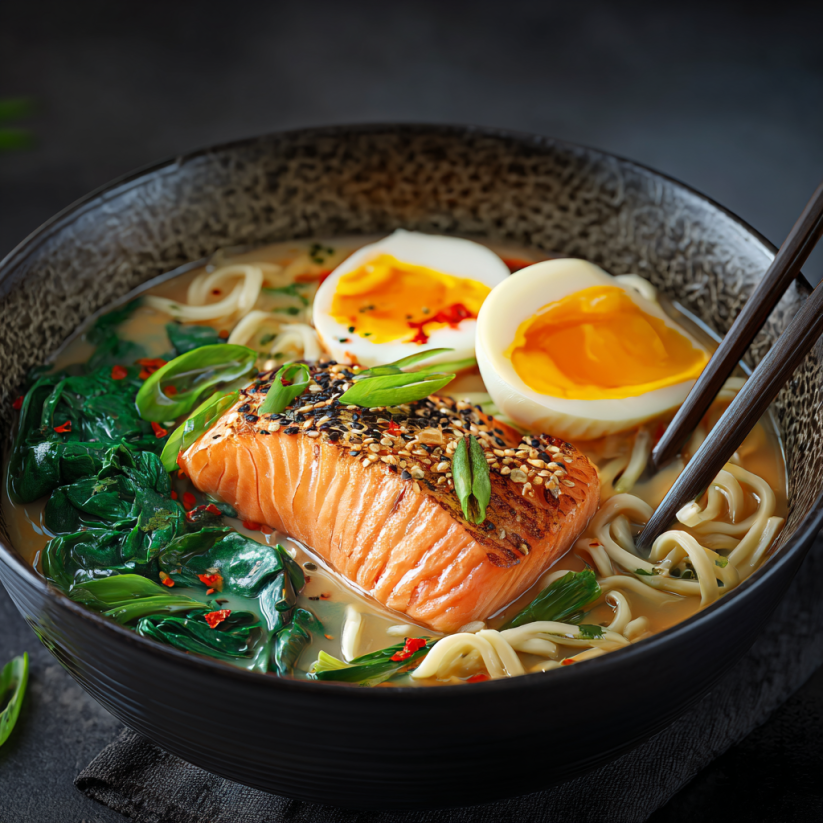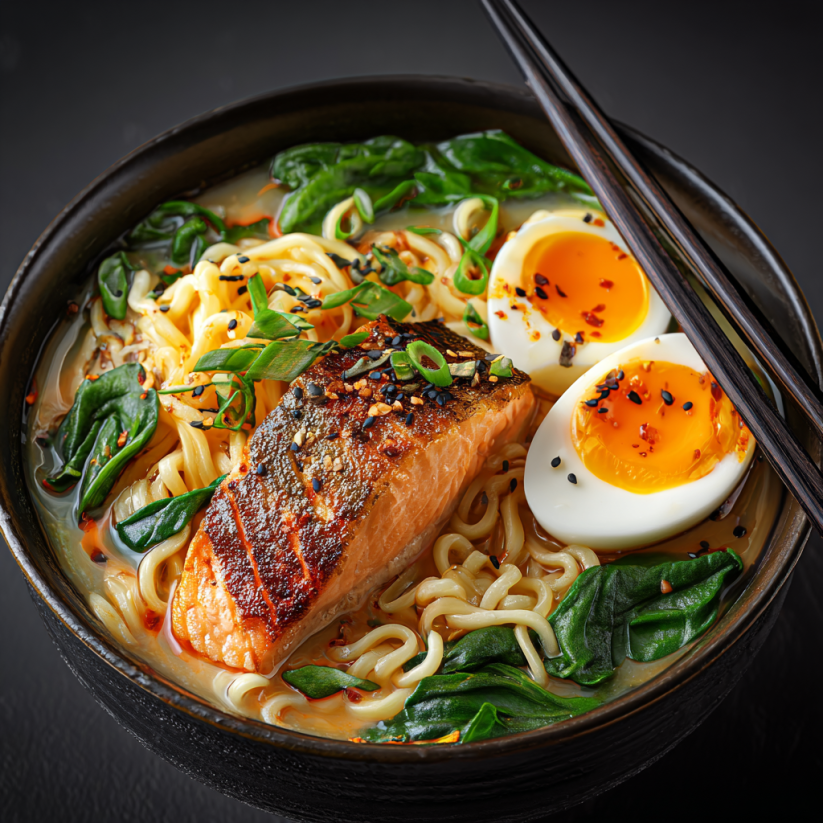 Bookmark
Bookmark
This easy Salmon Ramen with Coconut Milk is the recipe I always turn to when I want something deeply soothing but a little unique. Creamy coconut broth mingles with savory miso and soy, wrapping flaky salmon and springy ramen noodles in pure comfort. The mix of fresh aromatics, bright lime, and a gentle hit of spice makes every bowl a small adventure for the palate. It is the perfect blend of quick, healthy, and restaurant-quality—right at home.
The first time I made this, it was a cold weeknight and I needed dinner fast. It is now on repeat because my family loves how each person can build their perfect bowl, whether they want it hot and spicy or mellow and creamy.
Ingredients
- Salmon fillets: Choose the freshest salmon you can find for a buttery texture and full flavor. Skin-on fillets hold together best while cooking
- Coconut milk: Use full fat for maximum creaminess. Opt for unsweetened—this keeps the soup savory
- Ramen noodles: Classic wavy noodles give you that iconic chew, but high-quality instant noodles work too
- Vegetable broth: A good vegetable broth lays down the flavor base. Avoid broth that is too salty or artificially flavored
- Garlic and ginger: Fresh is best for both. They create the fragrance and gentle heat that define the broth
- Red curry paste: Optional but great for spice and complexity. Use your favorite brand and adjust to taste
- Soy sauce: Look for a naturally brewed soy sauce, which gives more depth
- Lime juice: Freshly squeezed lime brightens the entire dish and makes the broth taste lively
- Fresh vegetables: Bok choy, bell peppers, mushrooms, carrots—choose what is crisp and colorful and slice it thin so it cooks quickly and stays vibrant
Step-by-Step Instructions
- Season the Salmon:
- Pat the salmon fillets dry, then season both sides with salt and pepper until evenly coated. This helps build the flavor right from the start and helps the fish caramelize in the pan
- Sear the Salmon:
- Heat olive oil in a skillet over medium-high heat until shimmering. Place the salmon fillets skin side down first. Let them cook undisturbed for 3 to 4 minutes per side. Do not move them too soon so you get a golden crust without sticking. Remove and set aside when just cooked through
- Sauté Aromatics and Veggies:
- In a large soup pot, add a bit of fresh oil. Add minced ginger and garlic and cook them over medium heat just until fragrant and soft, about 1 to 2 minutes. Add in sliced mushrooms and bell pepper and sauté another 3 to 4 minutes, until just tender but still colorful
- Build the Broth:
- Pour in vegetable broth and coconut milk. Stir in soy sauce and the red curry paste if using. Let the mixture come to a gentle simmer. Taste and adjust salt and pepper. Let it simmer on low to meld the flavors for about 5 more minutes
- Cook the Noodles:
- Prepare ramen noodles in a separate pot according to package directions. Drain well so they do not water down the soup. This keeps the texture just right
- Assemble the Bowls:
- Place equal amounts of drained ramen noodles into each bowl. Gently flake the seared salmon and settle on top of the noodles. Ladle generous helpings of hot coconut broth over everything so the flavors mingle
- Finish With Freshness:
- Squeeze a wedge of lime over each bowl just before serving. Garnish with chopped cilantro or green onions and any other favorite toppings. Serve hot with extra lime wedges on the side for those who love a stronger citrus punch
 Bookmark
Bookmark
My favorite part is garnishing with a jammy soft boiled egg. Every time I crack one open over my ramen, I think of weekend lunches at home as a kid watching the yolk swirl into the broth. That combination of rich egg and creamy salmon broth is pure comfort for me.
Storage Tips
Let any leftovers cool to room temperature before refrigerating. Store broth and noodles separately so the noodles do not get mushy. Broth will keep for up to three days and can be reheated gently on the stovetop. For freezing, pour cooled broth into a freezer safe container but keep the noodles and salmon separate so they stay fresh when thawed.
Ingredient Substitutions
For the salmon, try using trout or Arctic char if that is available and fresh—both work beautifully in this broth. If you need to keep things vegan, swap the fish for crispy baked tofu and use vegetable broth throughout. Rice noodles also make a great substitute if ramen is hard to find.
 Bookmark
Bookmark
Serving Suggestions
Pile on toppings Play with crispy shallots, thinly sliced green onion, nori strips, pickled ginger, or toasted sesame seeds. Serve with a side of pickled veggies like daikon or cucumber. A soft cooked egg or handful of baby spinach will round out your bowl perfectly.
Ramen in Culinary History
Ramen’s story began as a simple street vendor’s meal in Japan, inspired by Chinese wheat noodles. Over the decades, it has become a canvas for bold flavors and endless creativity. Regional twists now range from creamy miso broths in the north to salty soy-based versions in the south. In homes like mine, it is a tradition that is always evolving with new ingredients and ideas.
Frequently Asked Questions About Recipes
- → Can I use leftover cooked salmon for this dish?
Yes, simply warm the salmon gently before adding to the noodles to preserve its texture and flavor.
- → What vegetables pair best with salmon ramen?
Bok choy, shiitake mushrooms, bell peppers, carrots, and spinach offer great texture and taste alongside the broth.
- → Is there a good substitute for coconut milk?
You can use light coconut milk for a less rich bowl, or try a creamy oat milk if dairy-free alternatives are needed.
- → How do I achieve a silky, non-greasy broth?
Simmer the coconut milk gently and avoid boiling vigorously; this helps maintain a smooth, creamy texture.
- → What toppings can enhance the flavor?
Soft eggs, green onions, sesame seeds, chili flakes, crispy shallots, and fresh herbs all add flavor and crunch.
- → Can this bowl be made spicy?
Add chili oil, red pepper flakes, or extra curry paste to bring up the heat according to your preference.
